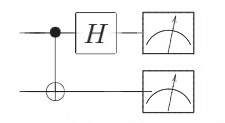The circuit elements are :
- CNOT gate, first qubit is the control bit
- Hadamard gate (H)
- The dials represent measurements made in the computational basis
Therefore, the circuit (without the measurements) is equivalent to $\text{CNOT}\;(H \otimes I)$.
My question is, how is this circuit equivalent to a Bell measurement?
In this paper (pages 14-15) the author mentions that the initial part of this circuit (without the measurements) is also equivalent to a change of basis from the computational basis to the Bell basis.
But at the same time, Nielsen and Chuang mention in their book (Quantum Computation and Information, Page 188) that the initial part is a change of basis from the Bell basis to the computational basis!! Which one is true and why is it true?
Edit :- By comparing the matrix of the net operation $\text{CNOT}\;(H \otimes I)$ and the actual change of basis matrix (from Bell to computational), as given in the paper, I could figure out that the circuit does represent a change of basis from the computational basis into the Bell basis. But why should both be true?

